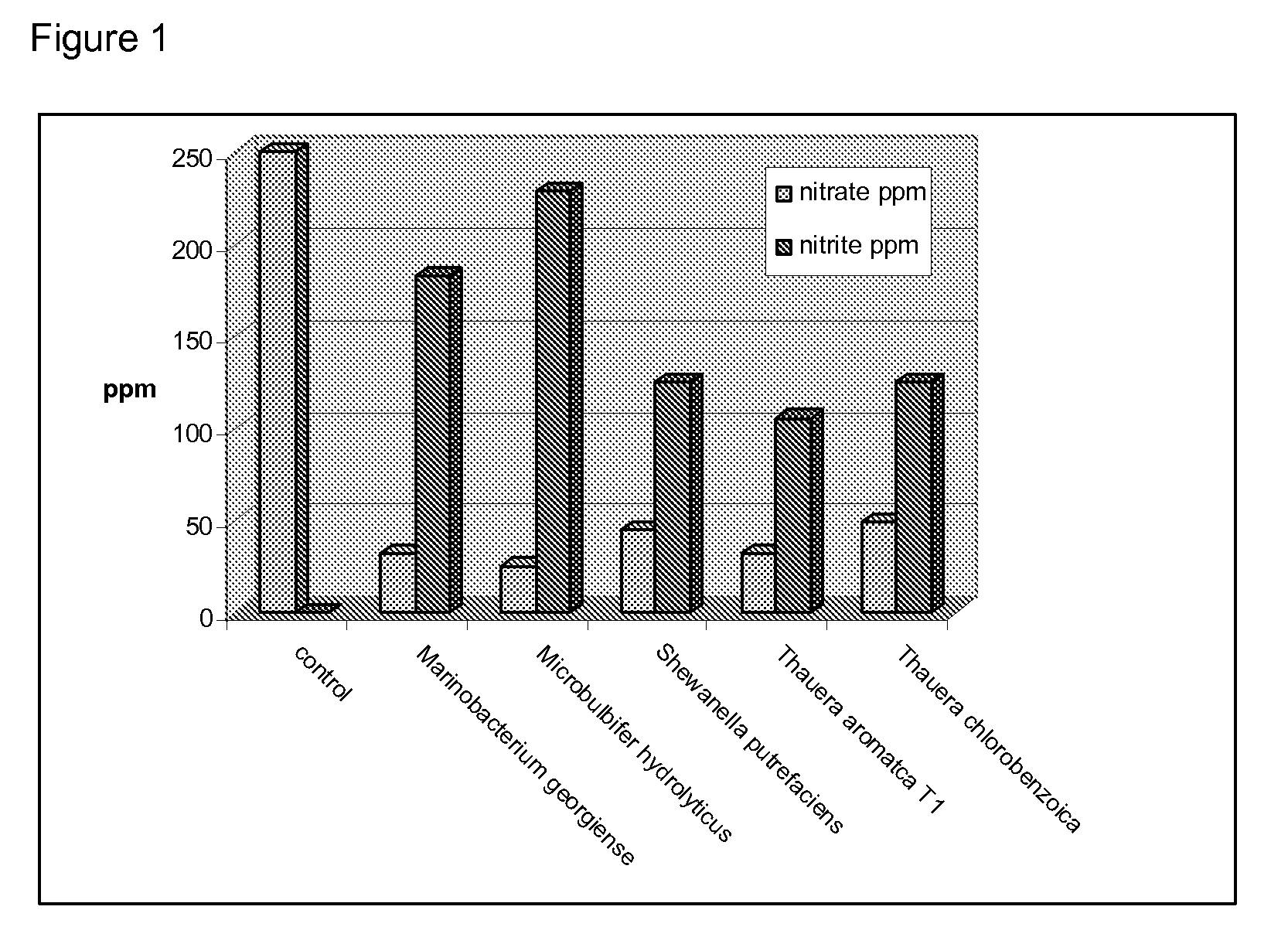Method for identification of novel anaerobic denitrifying bacteria utilizing petroleum components as sole carbon source
a technology of petroleum components and carbon sources, applied in the field of environmental microbiology and modification of heavy crude oil properties, can solve the problems of essentially immobile and cannot be easily recovered by conventional primary and secondary means, and achieve the effect of improving oil recovery
- Summary
- Abstract
- Description
- Claims
- Application Information
AI Technical Summary
Benefits of technology
Problems solved by technology
Method used
Image
Examples
example 1
Extraction of DNA from Reservoir Water Samples
[0085]Water samples were obtained from production well heads as mixed oil / water liquids in glass 1.0 L brown bottles, filled to the top, capped and sealed with tape to prevent gas leakage. Gas from inherent anaerobic processes sufficed to maintain anaerobic conditions during shipment. The bottles were shipped in large plastic coolers filled with ice blocks to the testing facilities within 48 hr of sampling.
[0086]After overnight settling and separation of the oil / water layers, 1-4 liters of water was removed from various bottles by pipetting and filtered through Whatman #1 (Brentford, Great Britain) glass fiber filters on a 47 mm glass chimney filter unit. The glass fiber filter collected residual oil, debris and >10 micron microbial cells. Subsequently, the water was filtered through sterile 0.22 micron Supor (Pall Corp., Ann Arbor, Mich.) nylon filters under vacuum. Microbial cells collected on the glass fiber filters or the Supor filte...
example 2
Generation of rDNA PCR Fragments
[0088]To generate rDNA of PCR amplified fragments representative of microbial species in the pooled DNA samples, we chose primer sets from Grabowski et al. (supra). The combination of forward primer SEQ ID NO: 1 and SEQ ID NO: 2 was chosen to specifically amplify bacterial rDNA sequences.
[0089]The PCR amplification mix included: 1.0× GoTaq PCR buffer (Promega), 0.25 mM dNTPs, 25 pmol of each primer, in a 50 μl reaction volume. 0.5 μl of GoTaq polymerase (Promega) and 1.0 μl (20 ng) of sample DNA were added. PCR reaction thermocycling protocol was 5.0 min at 95° C. followed by 30 cycles of: 1.5 min at 95° C., 1.5 min at 53° C., 2.5 min at 72° C. and final extension for 8 min at 72° C. in a Perkin Elmer 9600 thermocycler (Waltham, Mass.). This protocol was also used with cells from either purified colonies or mixed species from enrichment cultures.
[0090]The 1400 base pair amplification products were visualized on 1.0% agarose gels. The PCR reaction mix ...
example 3
Plasmid Template Preparation
[0091]Large-scale automated template purification systems used Solid Phase Reversible Immobilization (Agencourt, Beverly, Mass.) (DeAngelis, M. M., et al., Nucleic Acid Res., 23, 4742-4743, 1995) The SPRI® technology uses carboxylate-coated, iron-core, paramagnetic particles to capture DNA of a desired fragment length based on tuned buffering conditions. Once the desired DNA is captured on the particles, they can be magnetically concentrated and separated so that contaminants can be washed away.
[0092]The plasmid templates were purified using a streamlined SprintPrep™ SPRI protocol (Agencourt).This procedure harvests plasmid DNA directly from lysed bacterial cultures by trapping both plasmid and genomic DNA to the functionalized bead particles and selectively eluting only the plasmid DNA. Briefly, the purification procedure involves addition of alkaline lysis buffer (containing RNase A) to the bacterial culture, addition of alcohol based precipitation reag...
PUM
 Login to View More
Login to View More Abstract
Description
Claims
Application Information
 Login to View More
Login to View More - R&D
- Intellectual Property
- Life Sciences
- Materials
- Tech Scout
- Unparalleled Data Quality
- Higher Quality Content
- 60% Fewer Hallucinations
Browse by: Latest US Patents, China's latest patents, Technical Efficacy Thesaurus, Application Domain, Technology Topic, Popular Technical Reports.
© 2025 PatSnap. All rights reserved.Legal|Privacy policy|Modern Slavery Act Transparency Statement|Sitemap|About US| Contact US: help@patsnap.com


